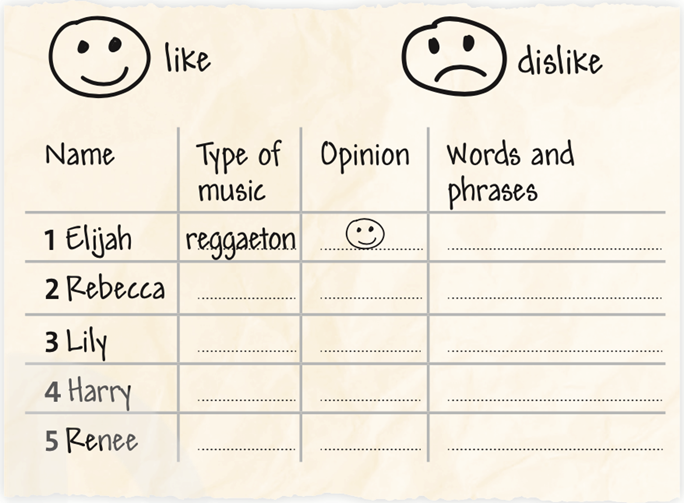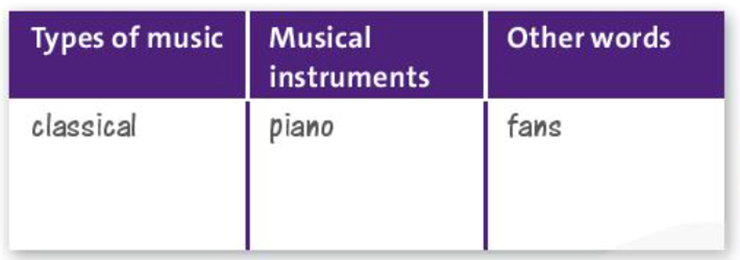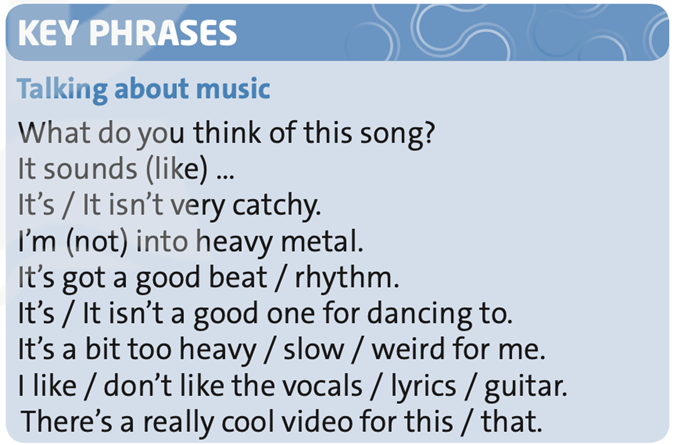Câu hỏi:
21/07/2024 91
Do the music quiz and compare your answers with your partner’s (Làm bài trắc nghiệm về âm nhạc và so sánh câu trả lời của bạn với câu trả lời bạn của bạn)
MUSIC QUIZ
1. The invention of the piano and violin changed the sounds of classical music. Violins become popular in the …
a. 6th century. b. 16th century. c. 20th century.
2. Traditional music is played with traditional instruments like these drums. Salsa and samba are two types of traditional music. They’re from …
a. the Caribbean and Brazil. b. Australia. c. Europe.
3. Pop became big in the 1960s. These are fans at a Beatles concert in the 1960s. The Beatles had more number one hits than any other pop band. The word 'pop' is from …
a. popcorn. b. population. c. popular.
4. Rock is harder, louder music than pop. Some 1970s bands were famous for their crazy clothes and angry lyrics. Their music was called …
a. punk rock. b. soft rock. c. rebel rock.
5. Hard rock and heavy metal have very loud vocals, guitars and bass. There's a type of
heavy metal called …
a. black metal. b. hot metal. c. chilli metal.
6. The first hip hop and rap came from DJs in …
a. London b. Rio de Janito c. New York
Do the music quiz and compare your answers with your partner’s (Làm bài trắc nghiệm về âm nhạc và so sánh câu trả lời của bạn với câu trả lời bạn của bạn)
MUSIC QUIZ
1. The invention of the piano and violin changed the sounds of classical music. Violins become popular in the …
a. 6th century. b. 16th century. c. 20th century.
2. Traditional music is played with traditional instruments like these drums. Salsa and samba are two types of traditional music. They’re from …
a. the Caribbean and Brazil. b. Australia. c. Europe.
3. Pop became big in the 1960s. These are fans at a Beatles concert in the 1960s. The Beatles had more number one hits than any other pop band. The word 'pop' is from …
a. popcorn. b. population. c. popular.
4. Rock is harder, louder music than pop. Some 1970s bands were famous for their crazy clothes and angry lyrics. Their music was called …
a. punk rock. b. soft rock. c. rebel rock.
5. Hard rock and heavy metal have very loud vocals, guitars and bass. There's a type of
heavy metal called …
a. black metal. b. hot metal. c. chilli metal.
6. The first hip hop and rap came from DJs in …
a. London b. Rio de Janito c. New York
Trả lời:
 Giải bởi Vietjack
Giải bởi Vietjack
1. b
2. a
3. c
4. a
5. a
6. c
Hướng dẫn dịch:
1. Sự phát minh ra piano và violin đã thay đổi âm thanh của âm nhạc cổ điển. Violins trở nên phổ biến vào thế kỷ 16.
2. Âm nhạc truyền thống được chơi với các nhạc cụ truyền thống như những chiếc trống này. Salsa và samba là hai loại hình âm nhạc truyền thống. Họ đến từ Caribe và Brazil.
3. Pop đã trở nên lớn vào những năm 1960. Đây là những người hâm mộ tại một buổi hòa nhạc của Beatles vào những năm 1960. The Beatles có nhiều bản hit số một hơn bất kỳ ban nhạc pop nào khác. Từ 'pop' là từ ‘popular’.
4. Rock khó hơn, nhạc to hơn pop. Một số ban nhạc những năm 1970 nổi tiếng với trang phục điên rồ và lời bài hát tức giận. Âm nhạc của họ được gọi là punk rock.
5. Hard rock và heavy metal có giọng hát, guitar và bass rất lớn. Có một loại kim loại nặng được gọi là black metal.
6. Hip hop và rap đầu tiên đến từ các DJ ở New York.
|
1. b |
2. a |
3. c |
4. a |
5. a |
6. c |
Hướng dẫn dịch:
1. Sự phát minh ra piano và violin đã thay đổi âm thanh của âm nhạc cổ điển. Violins trở nên phổ biến vào thế kỷ 16.
2. Âm nhạc truyền thống được chơi với các nhạc cụ truyền thống như những chiếc trống này. Salsa và samba là hai loại hình âm nhạc truyền thống. Họ đến từ Caribe và Brazil.
3. Pop đã trở nên lớn vào những năm 1960. Đây là những người hâm mộ tại một buổi hòa nhạc của Beatles vào những năm 1960. The Beatles có nhiều bản hit số một hơn bất kỳ ban nhạc pop nào khác. Từ 'pop' là từ ‘popular’.
4. Rock khó hơn, nhạc to hơn pop. Một số ban nhạc những năm 1970 nổi tiếng với trang phục điên rồ và lời bài hát tức giận. Âm nhạc của họ được gọi là punk rock.
5. Hard rock và heavy metal có giọng hát, guitar và bass rất lớn. Có một loại kim loại nặng được gọi là black metal.
6. Hip hop và rap đầu tiên đến từ các DJ ở New York.
CÂU HỎI HOT CÙNG CHỦ ĐỀ
Câu 1:
Watch or listen. What type of music does each person listen to, and what do they think of the music they hear? Complete the 'Type of music' column and draw a symbol for each name in the 'Opinion' column. (Xem hoặc nghe. Mỗi người nghe loại nhạc nào và họ nghĩ gì về loại nhạc họ nghe? Hoàn thành cột 'Loại nhạc' và vẽ biểu tượng cho từng tên trong cột 'Ý kiến'.)

Watch or listen. What type of music does each person listen to, and what do they think of the music they hear? Complete the 'Type of music' column and draw a symbol for each name in the 'Opinion' column. (Xem hoặc nghe. Mỗi người nghe loại nhạc nào và họ nghĩ gì về loại nhạc họ nghe? Hoàn thành cột 'Loại nhạc' và vẽ biểu tượng cho từng tên trong cột 'Ý kiến'.)

Câu 2:
Read the music quiz. Then add the blue words to the categories in the table. Listen and check (Đọc bài kiểm tra âm nhạc. Sau đó, thêm các từ màu xanh lam vào các danh mục trong bảng. Nghe và kiểm tra)

Read the music quiz. Then add the blue words to the categories in the table. Listen and check (Đọc bài kiểm tra âm nhạc. Sau đó, thêm các từ màu xanh lam vào các danh mục trong bảng. Nghe và kiểm tra)

Câu 3:
Watch or listen again. Which of the key phrases do you hear? Fill in the “Words and phrases” column in exercise 3 (Xem hoặc nghe lại. Bạn nghe thấy cụm từ khóa nào? Điền vào cột “Từ và cụm từ” trong bài tập 3)

Watch or listen again. Which of the key phrases do you hear? Fill in the “Words and phrases” column in exercise 3 (Xem hoặc nghe lại. Bạn nghe thấy cụm từ khóa nào? Điền vào cột “Từ và cụm từ” trong bài tập 3)

Câu 4:
USE IT!
Listen to three pieces of music. Answer questions 1-3 for each piece. (Nghe 3 bản nhạc. Trả lời câu hỏi 1-3 cho mỗi phần.)
1. What type of music is it?
2. What instruments do you hear?
3. What do you think of the music?
USE IT!
Listen to three pieces of music. Answer questions 1-3 for each piece. (Nghe 3 bản nhạc. Trả lời câu hỏi 1-3 cho mỗi phần.)
1. What type of music is it?
2. What instruments do you hear?
3. What do you think of the music?


